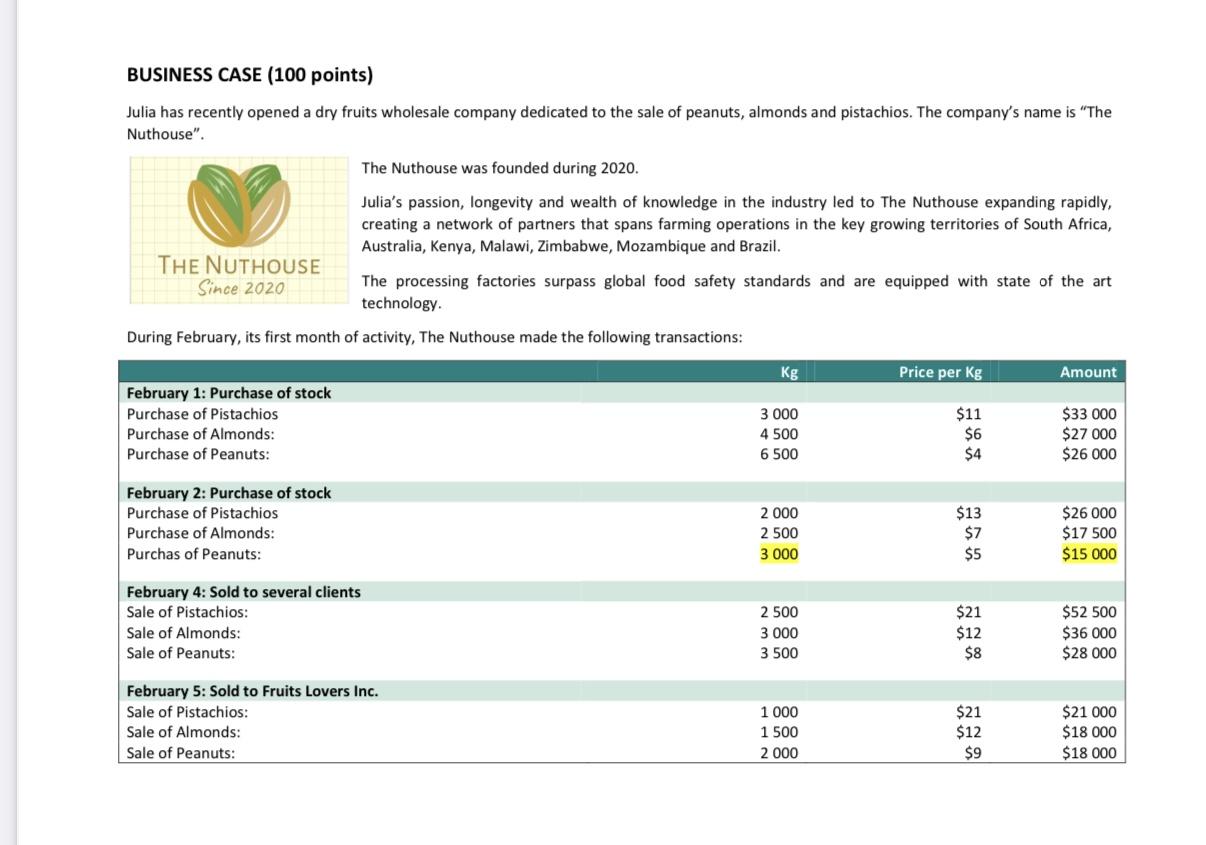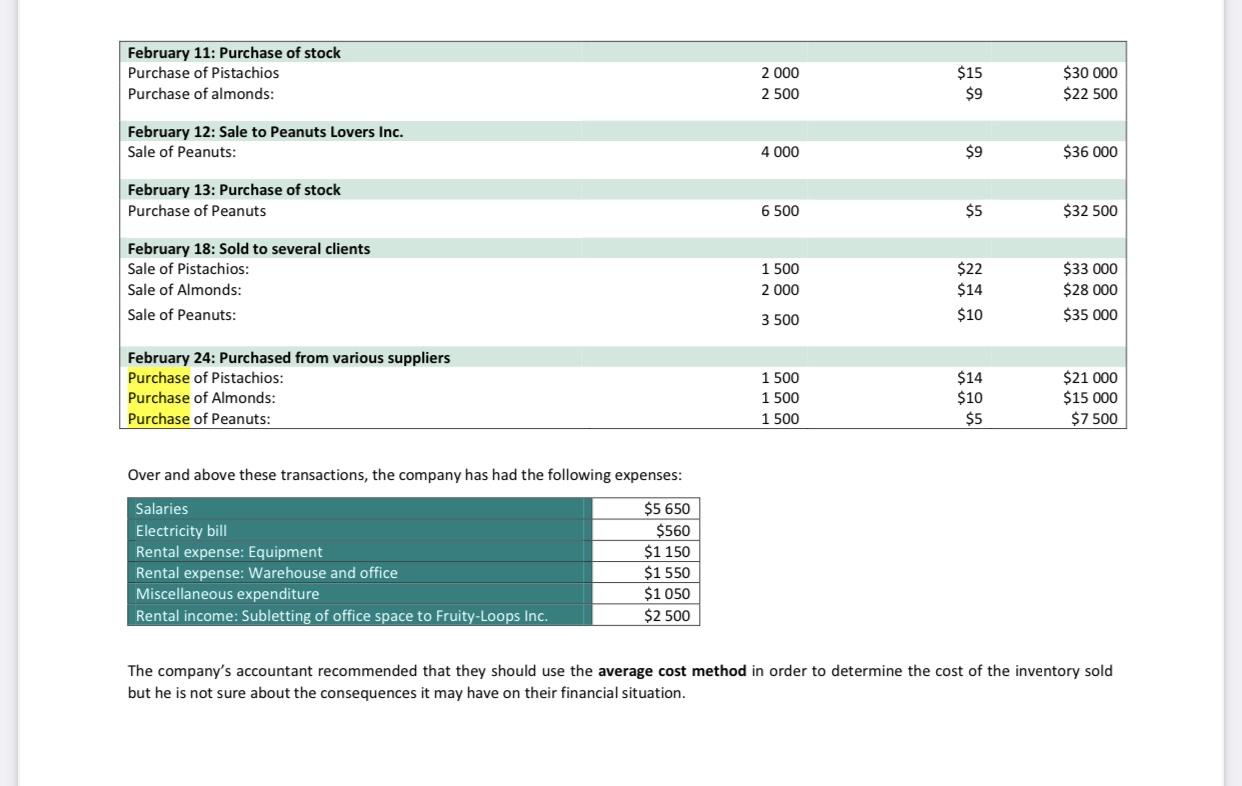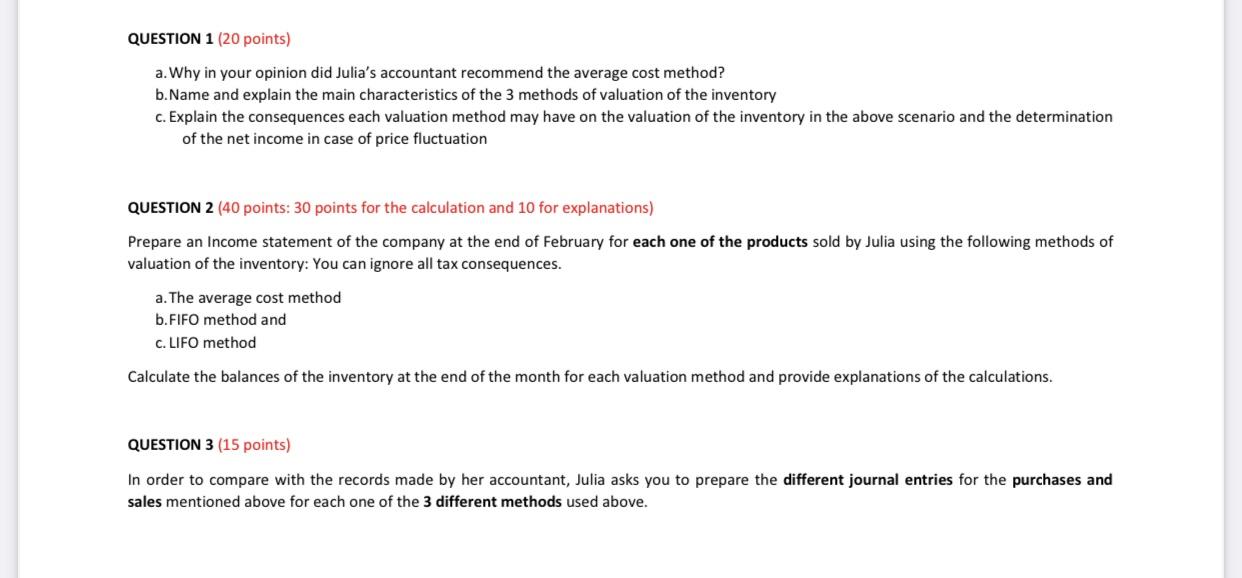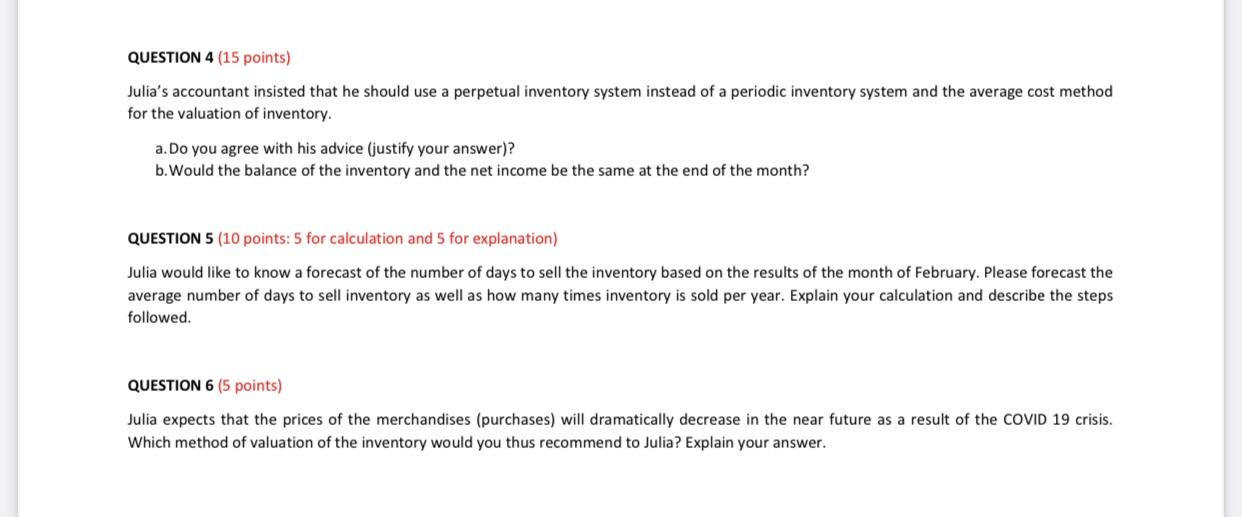BUSINESS CASE (100 points) Julia has recently opened a dry fruits wholesale company dedicated to the sale of peanuts, almonds and pistachios. The company's




BUSINESS CASE (100 points) Julia has recently opened a dry fruits wholesale company dedicated to the sale of peanuts, almonds and pistachios. The company's name is "The Nuthouse". THE NUTHOUSE Since 2020 During February, its first month of activity, The Nuthouse made the following transactions: February 1: Purchase of stock Purchase of Pistachios Purchase of Almonds: Purchase of Peanuts: The Nuthouse was founded during 2020. Julia's passion, longevity and wealth of knowledge in the industry led to The Nuthouse expanding rapidly, creating a network of partners that spans farming operations in the key growing territories of South Africa, Australia, Kenya, Malawi, Zimbabwe, Mozambique and Brazil. The processing factories surpass global food safety standards and are equipped with state of the art technology. February 2: Purchase of stock Purchase of Pistachios Purchase of Almonds: Purchas of Peanuts: February 4: Sold to several clients Sale of Pistachios: Sale of Almonds: Sale of Peanuts: February 5: Sold to Fruits Lovers Inc. Sale of Pistachios: Sale of Almonds: Sale of Peanuts: Kg 3 000 4 500 6 500 2 000 2 500 3 000 2 500 3 000 3 500 1 000 1 500 2 000 Price per Kg $11 $6 $4 $13 $7 $5 $21 $12 $8 $21 $12 $9 Amount $33 000 $27 000 $26 000 $26 000 $17 500 $15 000 $52 500 $36 000 $28 000 $21 000 $18 000 $18 000 February 11: Purchase of stock Purchase of Pistachios Purchase of almonds: February 12: Sale to Peanuts Lovers Inc. Sale of Peanuts: February 13: Purchase of stock Purchase of Peanuts February 18: Sold to several clients Sale of Pistachios: Sale of Almonds: Sale of Peanuts: February 24: Purchased from various suppliers Purchase of Pistachios: Purchase of Almonds: Purchase of Peanuts: Over and above these transactions, the company has had the following expenses: $5 650 $560 $1 150 $1 550 $1 050 $2 500 Salaries Electricity bill Rental expense: Equipment Rental expense: Warehouse and office Miscellaneous expenditure Rental income: Subletting of office space to Fruity-Loops Inc. 2 000 2 500 4 000 6 500 1 500 2 000 3 500 1 500 1 500 1 500 $15 $9 $9 $5 $22 $14 $10 $14 $10 $5 $30 000 $22 500 $36 000 $32 500 $33 000 $28 000 $35 000 $21 000 $15 000 $7 500 The company's accountant recommended that they should use the average cost method in order to determine the cost of the inventory sold but he is not sure about the consequences it may have on their financial situation. QUESTION 1 (20 points) a. Why in your opinion did Julia's accountant recommend the average cost method? b.Name and explain the main characteristics of the 3 methods of valuation of the inventory c. Explain the consequences each valuation method may have on the valuation of the inventory in the above scenario and the determination of the net income in case of price fluctuation QUESTION 2 (40 points: 30 points for the calculation and 10 for explanations) Prepare an Income statement of the company at the end of February for each one of the products sold by Julia using the following methods of valuation of the inventory: You can ignore all tax consequences. a. The average cost method. b. FIFO method and c. LIFO method Calculate the balances of the inventory at the end of the month for each valuation method and provide explanations of the calculations. QUESTION 3 (15 points) In order to compare with the records made by her accountant, Julia asks you to prepare the different journal entries for the purchases and sales mentioned above for each one of the 3 different methods used above. QUESTION 4 (15 points) Julia's accountant insisted that he should use a perpetual inventory system instead of a periodic inventory system and the average cost method for the valuation of inventory. a. Do you agree with his advice (justify your answer)? b. Would the balance of the inventory and the net income be the same at the end of the month? QUESTION 5 (10 points: 5 for calculation and 5 for explanation) Julia would like to know a forecast of the number of days to sell the inventory based on the results of the month of February. Please forecast the average number of days to sell inventory as well as how many times inventory is sold per year. Explain your calculation and describe the steps followed. QUESTION 6 (5 points) Julia expects that the prices of the merchandises (purchases) will dramatically decrease in the near future as a result of the COVID 19 crisis. Which method of valuation of the inventory would you thus recommend to Julia? Explain your answer.
Step by Step Solution
3.49 Rating (162 Votes )
There are 3 Steps involved in it
Step: 1
Working Note1 Computation of Closing stock in units PISTACHIOS Date Particulars Qty Rate Cost 01Feb Purchase 3000 11 33000 02Feb Purchase 2000 13 2600...
See step-by-step solutions with expert insights and AI powered tools for academic success
Step: 2

Step: 3

Ace Your Homework with AI
Get the answers you need in no time with our AI-driven, step-by-step assistance
Get Started


